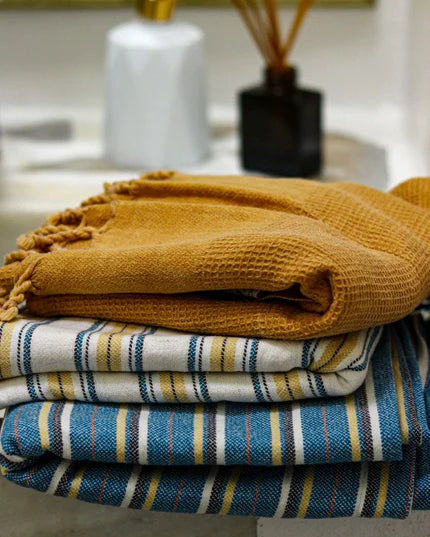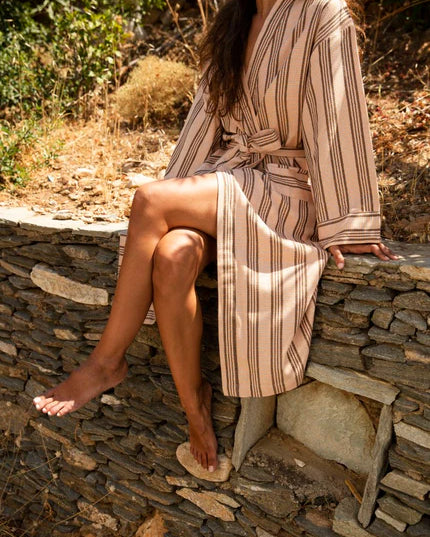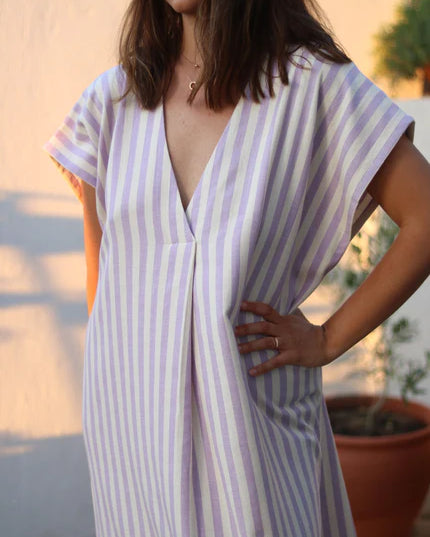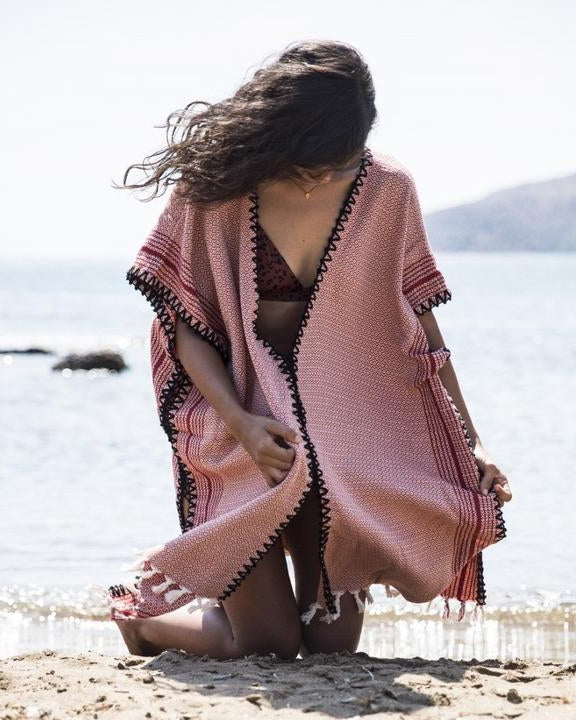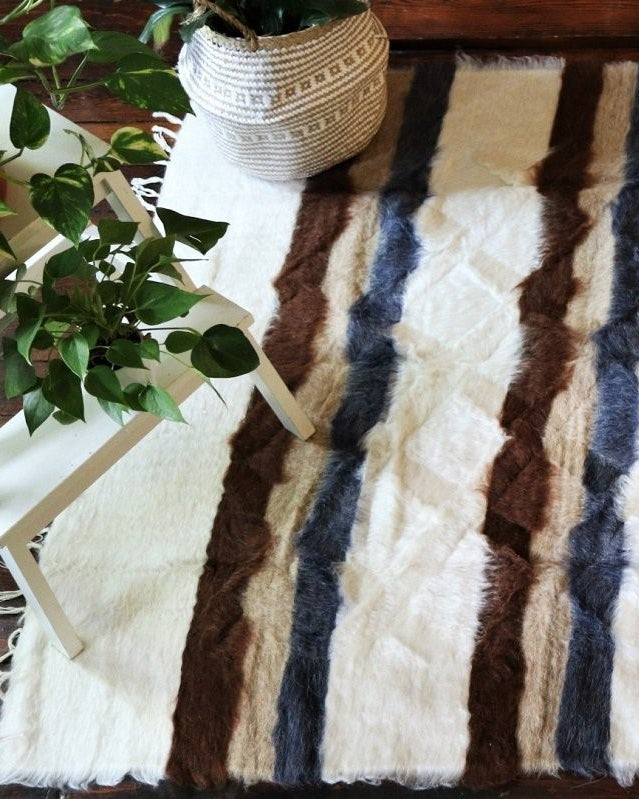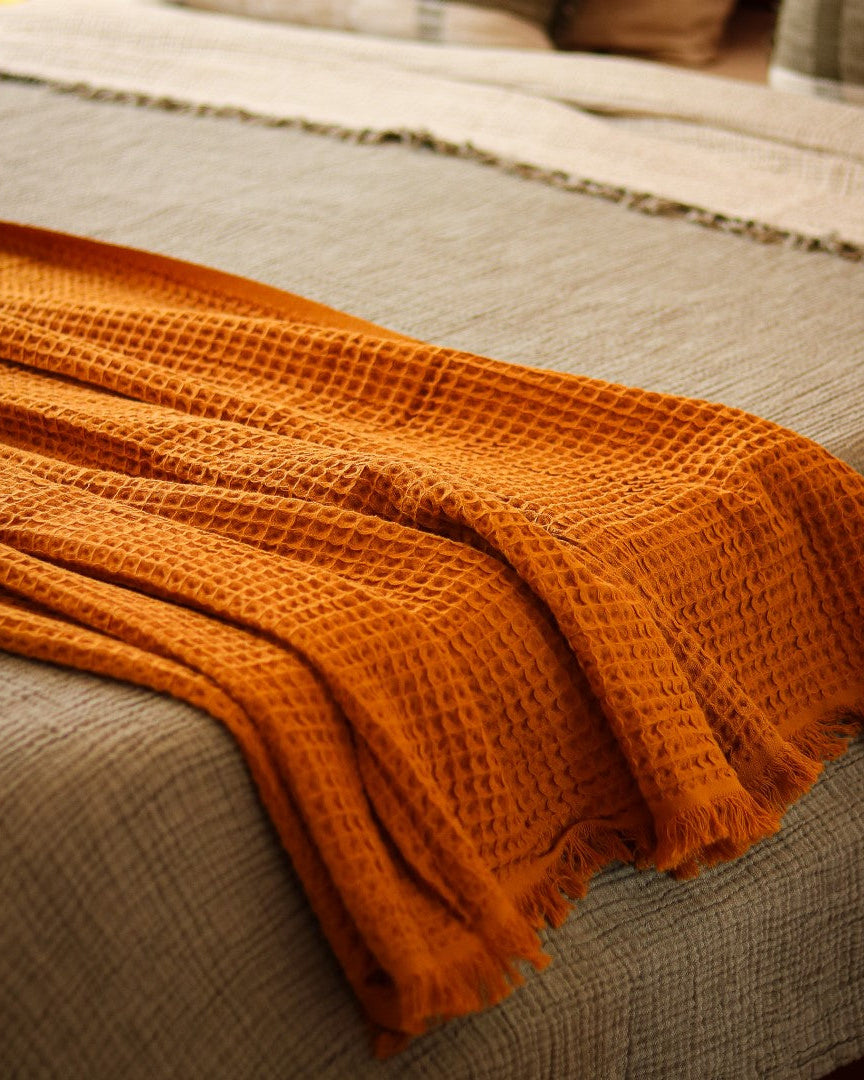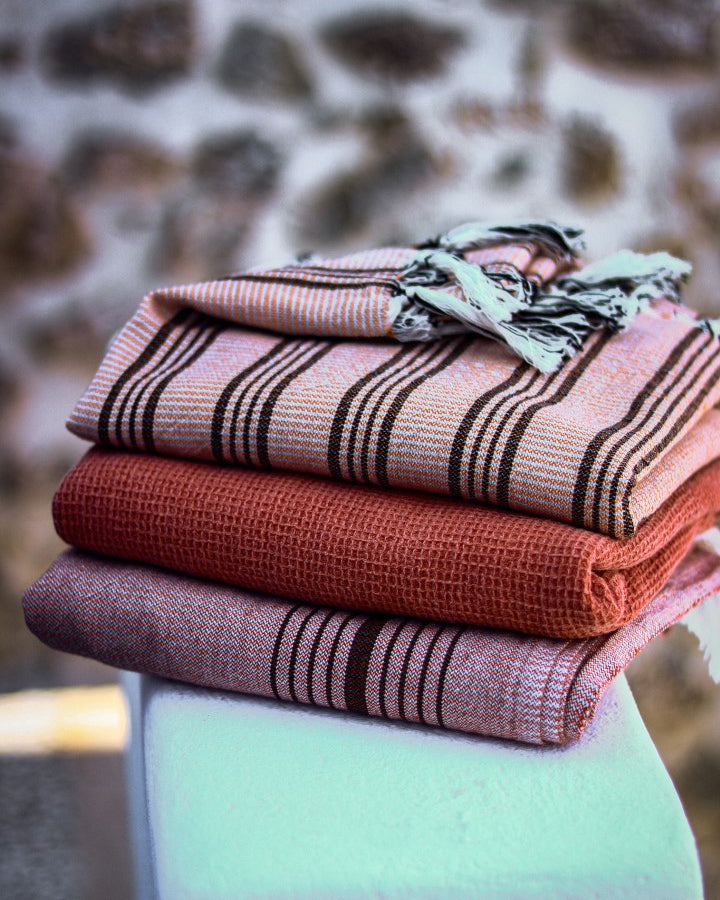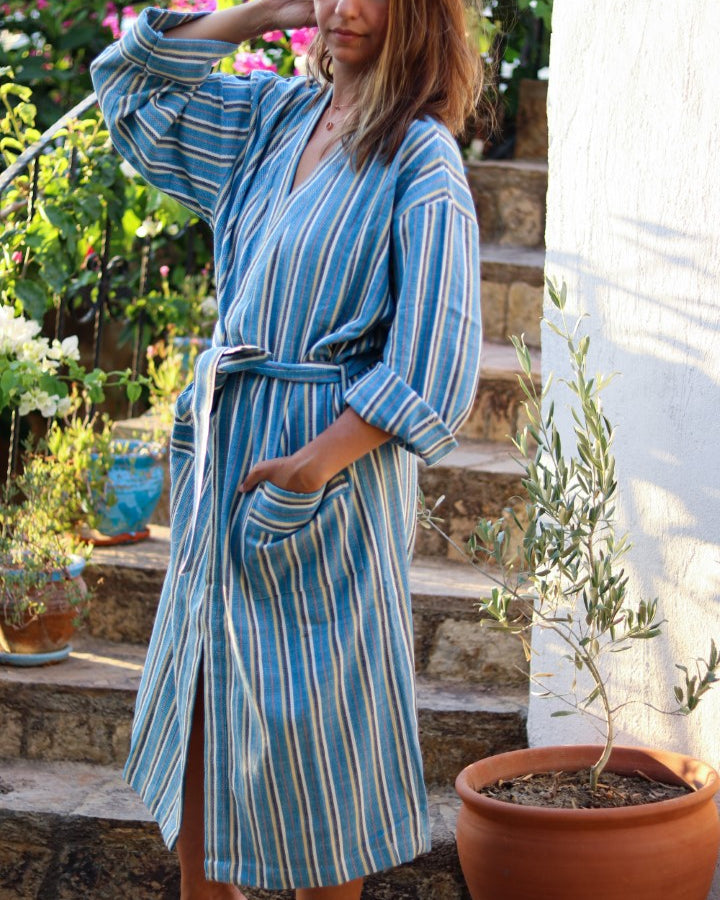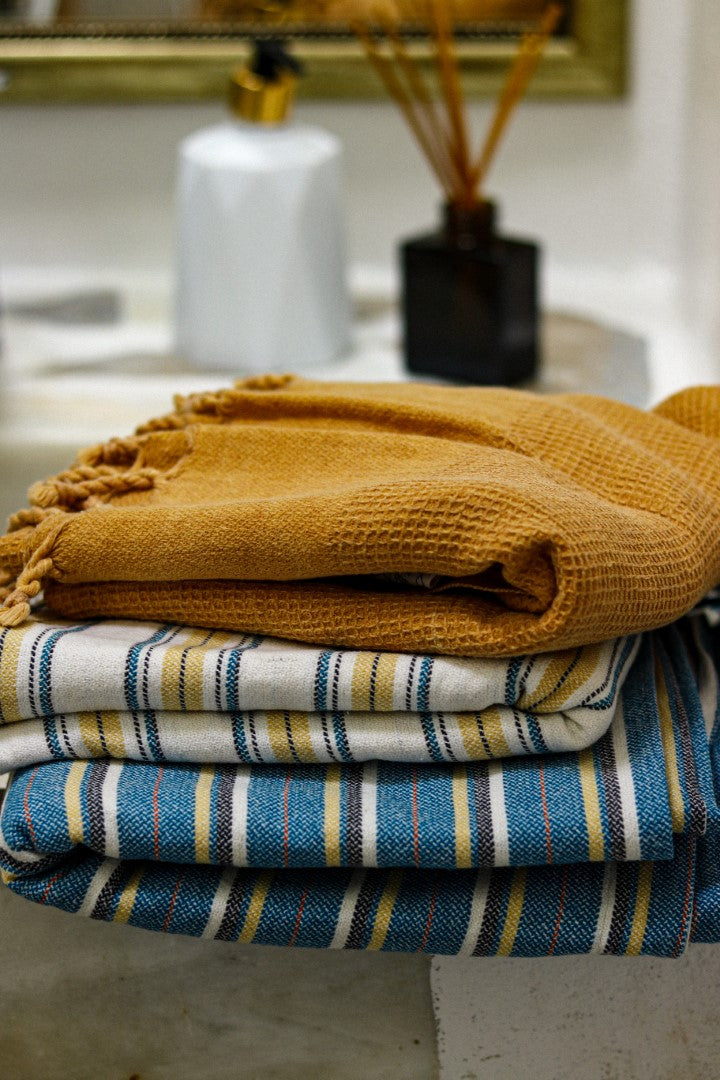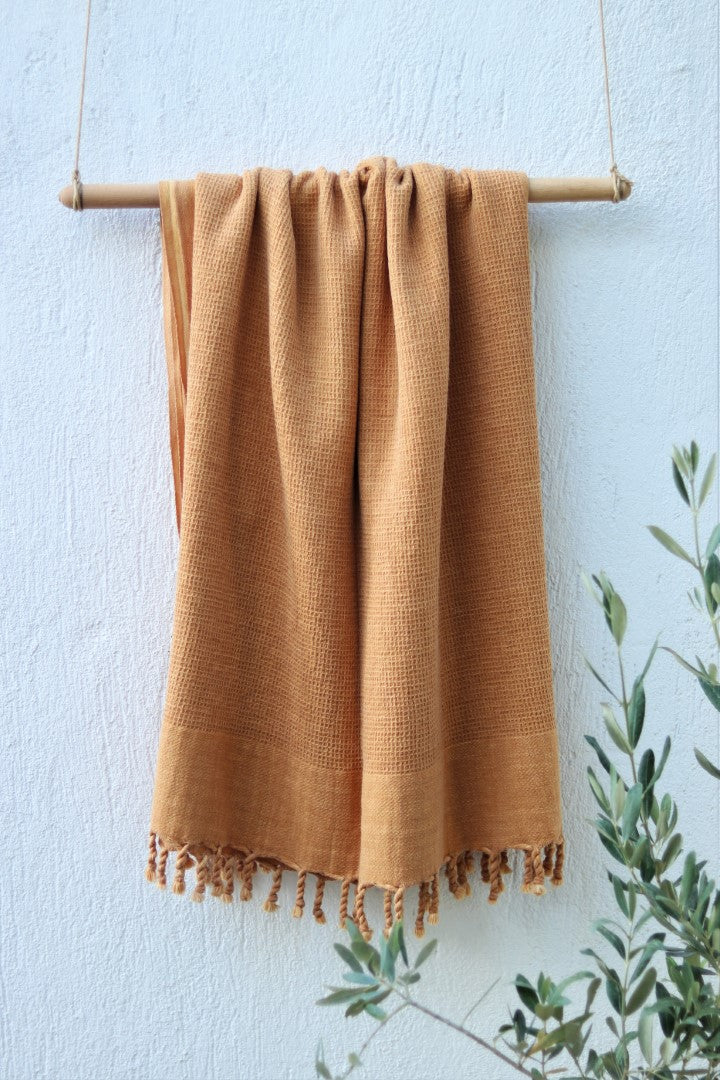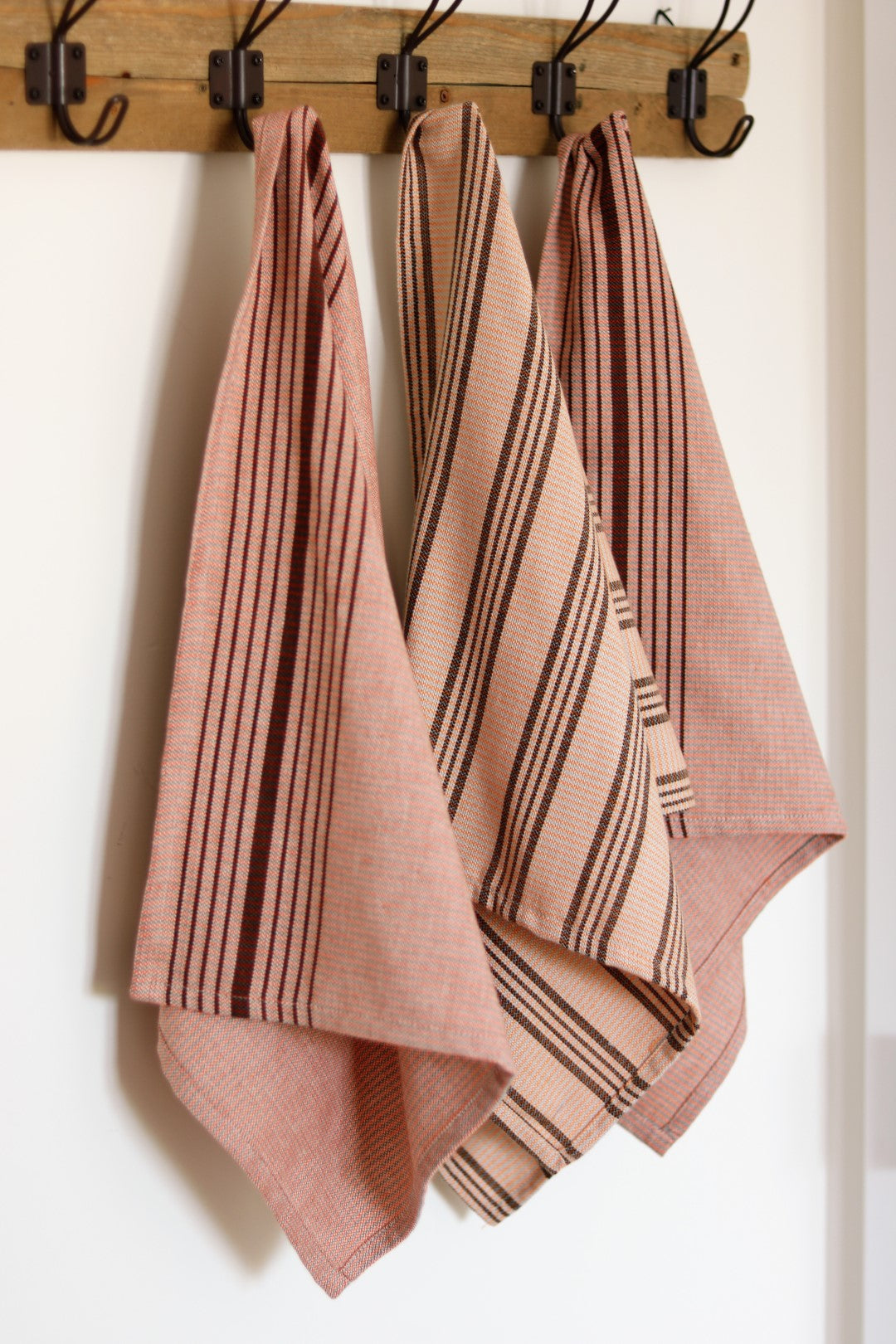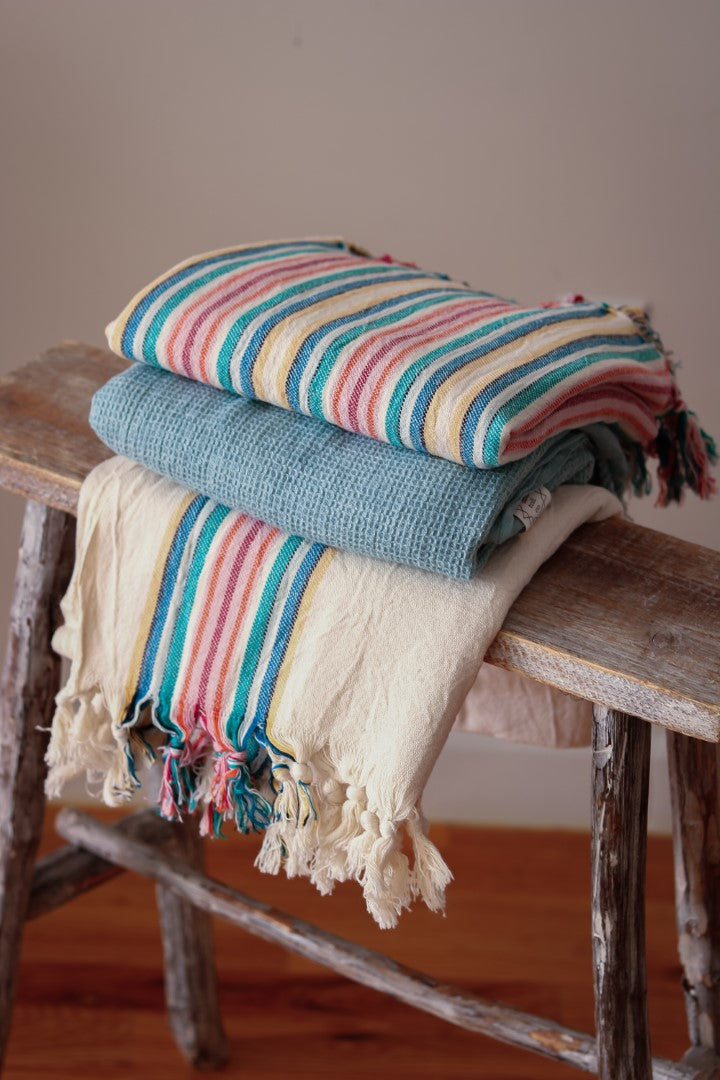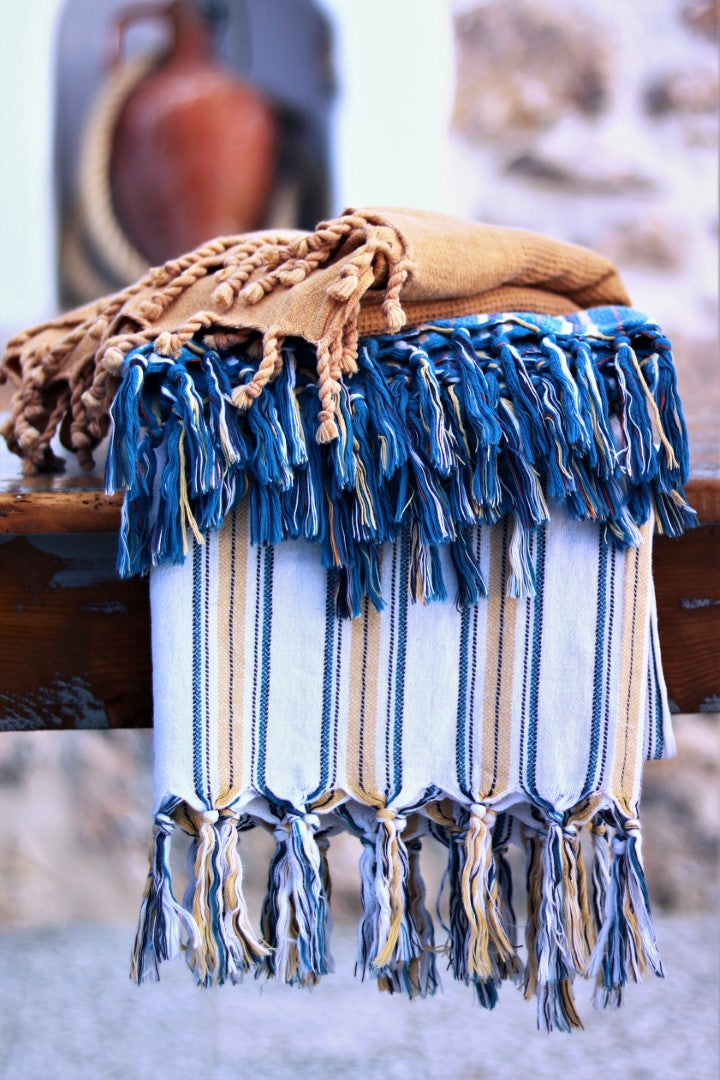When you think of Mediterranean decor, what comes to mind? Is it the sun-bleached walls of a Greek island villa or the rustic charm of a Tuscan farmhouse? It's all of that and more. This style is less about a strict set of rules and more about capturing a feeling—the slow, sun-drenched pace of life along the coast.
It's a beautiful blend of rustic simplicity and natural elegance, creating a space that feels like a serene, personal sanctuary. The whole philosophy revolves around bright, airy rooms, organic materials, and blurring the line between your living room and the garden outside.
Bringing the Mediterranean Lifestyle Home
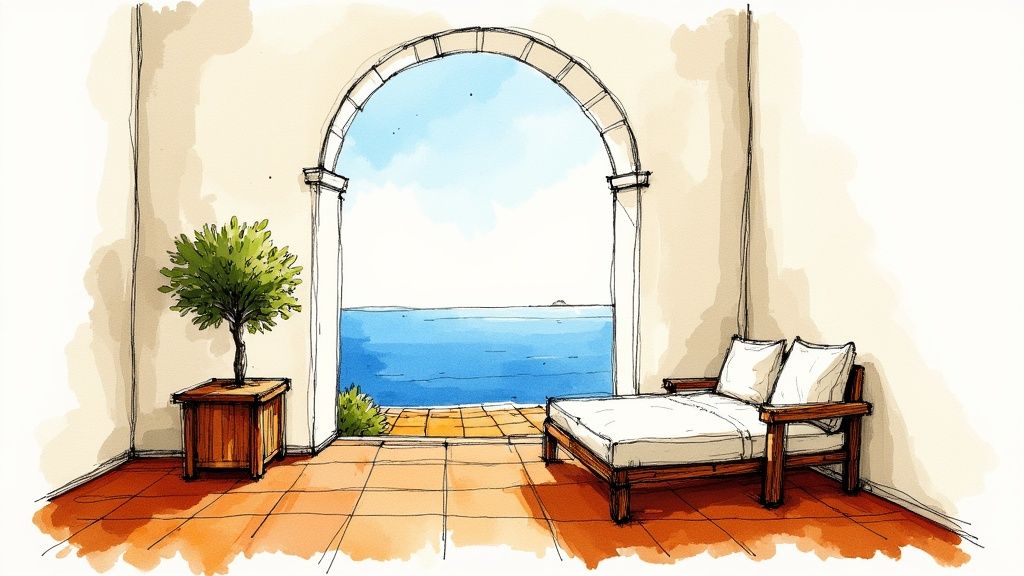
Picture a home where life just feels a little slower, where sunlight streams into every corner, and comfort is woven into the very fabric of the space. That’s the real heart of Mediterranean style. It’s not a fleeting trend but a timeless approach to living that’s deeply connected to nature and simplicity.
This guide is your starting point for bringing that rustic sophistication home. We'll walk through everything from the quintessential color palettes to the handcrafted textures that truly define the look. You’ll see how you can capture that serene, inviting spirit and turn your own space into a personal haven, no matter where you live.
Why This Style Endures
The lasting appeal of Mediterranean design comes down to its warmth and authenticity. It’s a style that embraces the perfectly imperfect. Instead of sterile, flawless interiors, it celebrates the beauty of a well-loved, lived-in home filled with handcrafted goods and natural character.
This approach has given it serious staying power. While Mediterranean-style homes account for just over 4% of all homes for sale in the United States, they fetch some of the highest median prices, averaging around $725,000. It’s a testament to its timeless value.
This focus on natural, long-lasting materials also fits perfectly with the growing desire for more mindful living. To really lean into the Mediterranean philosophy, you can weave in principles of eco-friendly home decor and create a space that’s not only beautiful but sustainable, too.
The Mediterranean Lifestyle respects and understands how to live symbiotically with the environment. It’s about embracing traditions and limiting disruptive globalized lifestyle trends.
At the end of the day, authentic textiles are what tie this whole soulful look together. Soft, natural fabrics—like the ones we create at Anatolico—add those essential layers of comfort and character, turning a house into a warm, truly inviting home.
The Three Pillars of Mediterranean Design
To truly bring the Mediterranean spirit into your home, you need to think beyond just picking out furniture or paint colors. The whole aesthetic is built on three core ideas that work together to create that signature sense of warmth, ease, and tranquility. Once you understand these pillars, crafting an authentic space becomes second nature.
This simple diagram lays out the three principles that are the heart and soul of Mediterranean design.
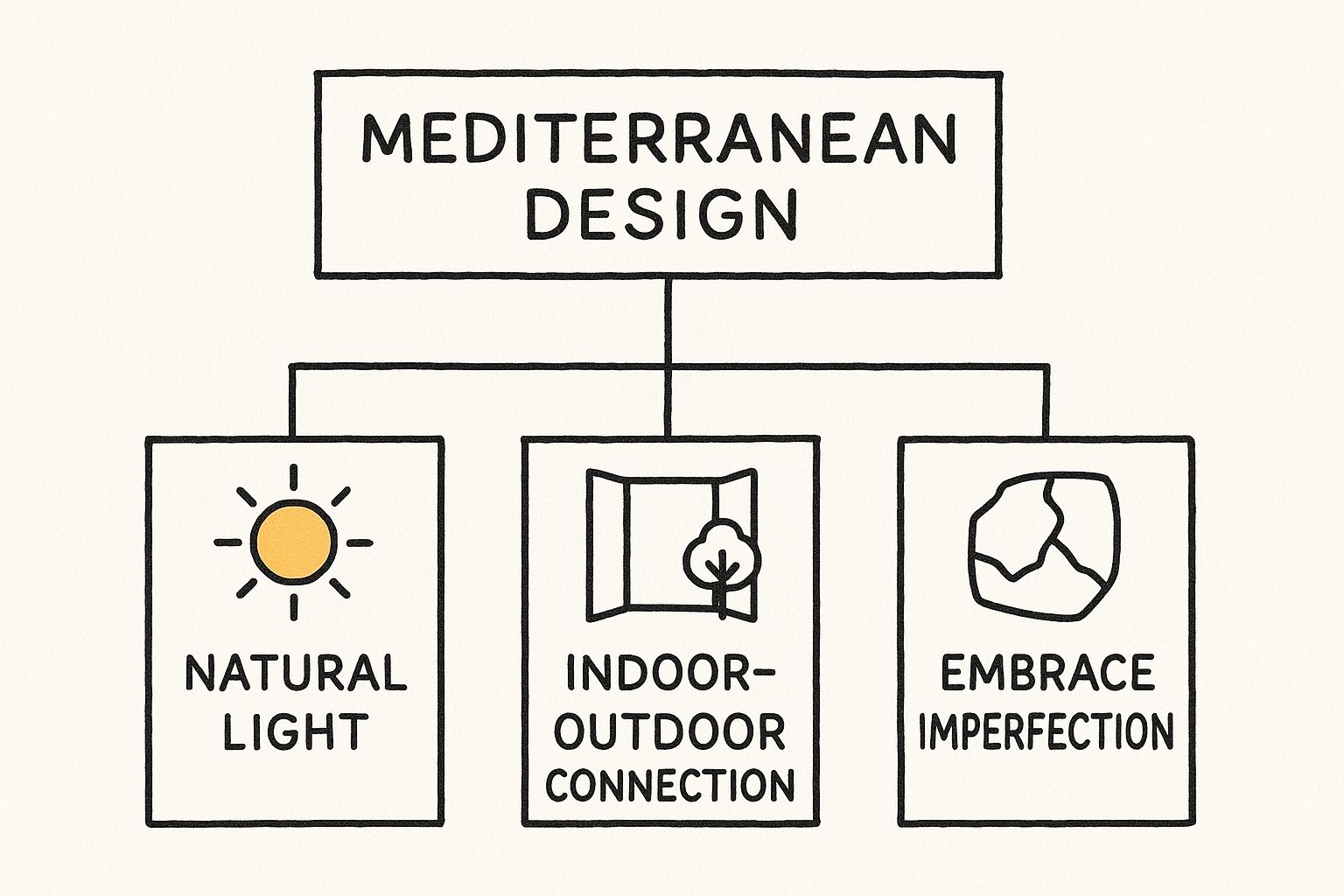
As you can see, the style is a beautiful balance of celebrating natural light, connecting with the outdoors, and finding charm in the imperfect. They all play off each other perfectly.
Here is a quick look at the fundamental components that shape the Mediterranean style.
Key Elements of Mediterranean Decor at a Glance
| Element | Description | Examples |
|---|---|---|
| Natural Light | Maximizing and celebrating sunlight to create an airy, bright atmosphere. | Sheer linen curtains, white-washed walls, strategically placed mirrors. |
| Indoor-Outdoor Flow | Blurring the lines between the home and nature for a seamless living experience. | Terracotta pots with olive trees, open patio doors, natural materials. |
| Wabi-Sabi Imperfection | Finding beauty in handcrafted, aged, and slightly flawed objects. | Hand-thrown ceramics, weathered wood furniture, handwoven textiles. |
This table serves as a handy reference, but let's explore what each of these pillars truly means for your home.
Celebrate Natural Light
In a Mediterranean home, sunlight isn't just a utility; it's the main event. You have to start thinking of your windows less as openings and more as frames for capturing and amplifying daylight. While homes in the region often have fewer or smaller windows to keep out the intense heat, they are masters at making every single sunbeam count by using light colors and reflective surfaces.
This isn't about needing huge, floor-to-ceiling windows. It’s all about how you manage the light you already have. For instance, sheer linen curtains can filter harsh afternoon sun into a soft, ethereal glow. A well-placed mirror can bounce light into a dim corner, making the whole room feel bigger and brighter. The real goal is to create that sun-kissed feeling that just makes you happy to be home.
Connect Indoor and Outdoor Spaces
Another cornerstone of the style is creating a seamless, easy flow between inside and out. It’s about blurring those boundaries and inviting the natural world right into your home. This philosophy comes from a lifestyle where patios, gardens, and courtyards aren't afterthoughts—they’re extensions of the main living area.
You can create this connection in a few simple ways:
- Bring in big plants: Nothing says Mediterranean garden like a potted olive tree in the corner or fragrant herbs lining a kitchen windowsill.
- Use natural materials: Using materials like stone, wood, and terracotta inside the house helps echo the textures you'd find right outside.
- Keep doors open: Whenever the weather allows, leaving doors open to a balcony or patio creates an undeniable physical and visual link to the outdoors.
Embrace Wabi-Sabi Imperfection
Finally, this style truly finds its soul in imperfection. It’s the complete opposite of a sterile, mass-produced look. Mediterranean decor is all about celebrating the one-of-a-kind character of handcrafted items, the beautiful patina on a piece of aged wood, and the subtle color variations in handmade tiles. This idea is often called wabi-sabi—a philosophy that finds beauty in things that are transient and imperfect.
This embrace of the imperfect is what gives a room that lived-in, genuinely welcoming feeling. It’s about choosing a ceramic vase with a slightly uneven glaze or a handwoven Anatolico towel with its unique texture over something that came off a factory line.
This pillar is all about authenticity. It's a celebration of objects that have a story to tell, which adds a depth and personality that a flawlessly polished space can never quite capture. It's what makes a house feel less like a showroom and more like a warm, inviting home.
Building Your Natural Color and Material Palette
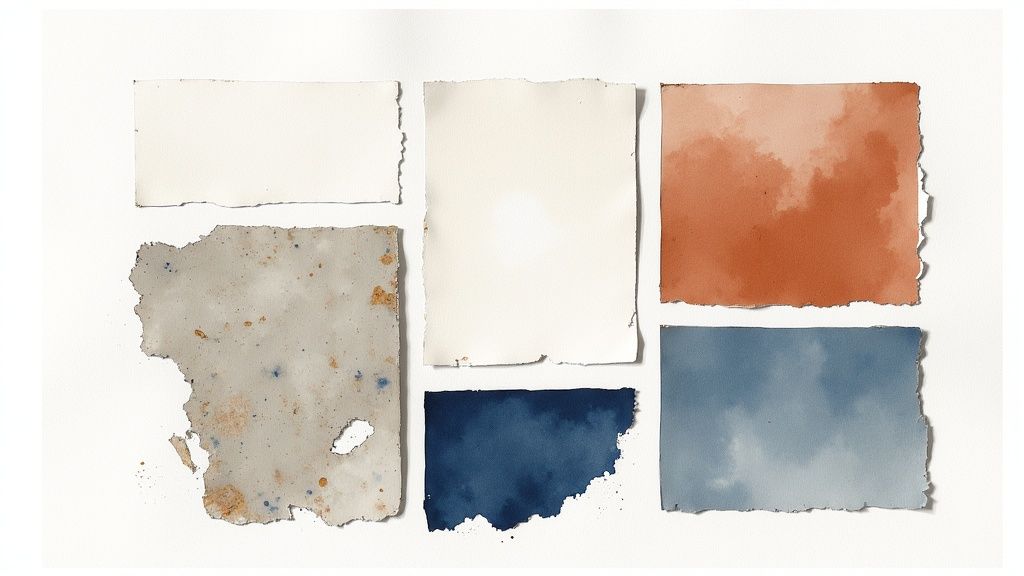
To capture the true spirit of a Mediterranean home, you have to start with the colors and textures found right outside its doors. Forget fleeting trends; this is about borrowing directly from the coastal landscape—the sun, the sea, the earth—and inviting it inside.
Everything begins with a brilliant, sun-bleached white. It’s the perfect backdrop, bouncing light around the room and creating that essential feeling of open, airy space. This crisp white is your canvas, but it’s the accents you paint on it that truly bring the story to life.
Once you have your foundation, you can start layering in the colors of the environment. Think of the deep, calming blues of the Aegean Sea, the soft greens of olive groves, or the sun-baked ochre and terracotta that color a Spanish village. These hues are what ground the space and give it warmth.
Crafting Your Color Story
Choosing your palette is a bit like deciding where on the coast you want your home to be. Each combination sets a completely different mood.
Here are a few classic palettes to get you started:
- Greek Island Cool: Begin with a dominant, clean white. Then, weave in shades of cobalt and azure blue to echo the sea and sky, maybe with a few touches of soft gray like the ones you'd find in coastal pebbles.
- Tuscan Warmth: Instead of stark white, go for a creamy, off-white base. Layer this with earthy tones—terracotta, burnt orange, deep yellows, and rich olive green—to create a rustic, sun-drenched atmosphere.
- Spanish Revival Richness: Pair warm beiges with pops of vibrant color. Think rich reds, deep blues, and accents of turquoise, often brought in through patterned tiles and textiles.
This move toward natural, sustainable elements is more than just a Mediterranean thing; it’s a global shift. The home decor market is seeing a huge surge in designs that favor organic materials, which is exactly what this style has always been about. You can find more insights on this trend over at imarcgroup.com.
Layering with Natural Materials
With your colors in place, it’s time to bring in texture. This is the secret ingredient that gives Mediterranean decor its touchable, inviting quality. The goal is to create a mix of materials that feel authentic, organic, and maybe even a little worn by time.
At its heart, this style is a conversation between different textures. The cool, smooth surface of stone plays off the warmth of wood, while the rough finish of plaster is softened by the gentle drape of linen.
Think of these as the essential building blocks for your space:
- Rustic Wood: Look for weathered, sun-bleached, or dark-stained finishes on beams, furniture, and floors. Every knot and imperfection tells a story and adds character.
- Wrought Iron: This adds a touch of cool, dark contrast and elegant craftsmanship. You'll see it in light fixtures, railings, and the legs of a simple side table.
- Natural Stone: Materials like travertine, limestone, or marble are perfect for floors and countertops, bringing a timeless, cooling element indoors.
- Textured Plaster: Move away from perfectly flat, smooth walls. A subtle texture from plaster or limewash gives walls a soft, organic depth that paint just can't replicate.
- Linen: Frankly, no Mediterranean space feels complete without it. As a fabric, linen is breathable, beautiful, and its natural texture is the perfect finishing touch. You can learn more about how eco-friendly is linen in our detailed article.
The Essential Role of Textiles and Handcrafted Goods
If colors and materials are the bones of a Mediterranean home, then textiles are its very soul. They bring in the softness, the comfort, and the tactile quality that transforms a room from just a space into a genuine home. Without them, even a perfectly structured room can feel a bit cold, a little incomplete.
This is where you layer in that final, crucial touch of warmth. Natural fibers are everything here, with linen, cotton, and wool leading the way. Their organic textures and inherent breathability are the perfect counterpoint to the rustic wood and cool stone we’ve been talking about.
Weaving in Comfort and Character
It’s amazing how the right textiles can completely shift the feeling of a room. We’re not talking about huge, dramatic changes, but simple, well-chosen additions. An Anatolico linen towel casually draped in a bathroom, for instance, instantly brings a sense of spa-like calm and understated elegance.
Think about a soft Turkish cotton throw blanket tossed over the arm of a sofa—it's an open invitation to sit down and get comfortable. This particular cotton is famous for its long fibers, which result in a fabric that’s as durable as it is soft. We get into all the details in our full guide on what is Turkish cotton. These little touches create the layers of comfort that are so central to the Mediterranean lifestyle.
In Mediterranean decor, textiles are never just an afterthought. They are one of the main ways to inject personality, texture, and a sense of history into your home.
Choosing the right pieces is about more than just matching colors; it’s about how they feel. A handwoven wool rug under your feet, for example, provides a grounding warmth that beautifully balances the coolness of tile or stone floors.
The Value of Artisanal Quality
In a design philosophy that honors imperfection and authenticity, handcrafted goods are non-negotiable. Mass-produced items just can’t replicate the unique spirit that gives a Mediterranean home its character. When you choose artisanal pieces, you're tying your home to a deep and rich tradition of craftsmanship.
When you bring a handwoven textile into your space, you're not just buying an object. You're bringing a story home. Each piece has its own subtle variations and the unique touch of the person who made it, a clear nod to quality over quantity. This idea aligns perfectly with the slow-living ethos that sits at the heart of the style.
These key elements add that final, essential layer of personality:
- Handwoven Rugs: Go for simple patterns in natural wool or jute to ground the space with texture.
- Linen Curtains: Sheer linen lets that beautiful, soft light filter through, making everything feel open and airy.
- Embroidered Pillows: These are a fantastic way to add a bit of detailed craftsmanship and a pop of color.
- Turkish Towels: Their distinctive weave and beautiful drape make them as stylish as they are practical, perfect for the bath or the beach.
At the end of the day, these handcrafted textiles and goods are what truly complete the picture. They are the details that turn a collection of beautiful things into a warm, inviting, and deeply personal sanctuary.
Designing Your Mediterranean-Inspired Rooms
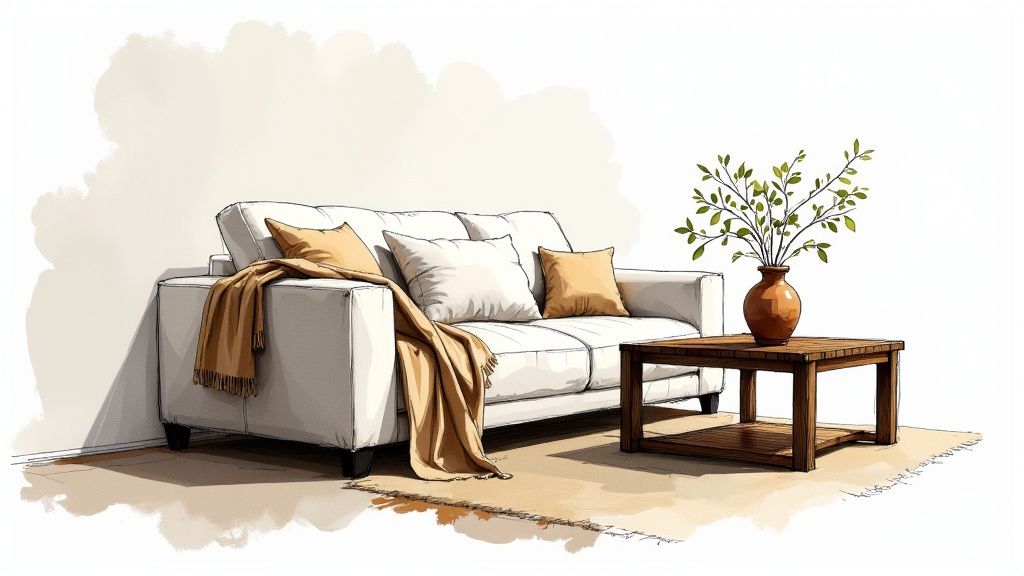
Alright, you've got the building blocks—the colors, materials, and textiles that form the soul of Mediterranean design. Now for the fun part: pulling it all together. Let’s walk through how to apply these ideas room by room, transforming your home into a place that feels cohesive and genuinely welcoming.
Think of each room as a chapter in your home's story. The living room can be a space for easygoing conversation, the kitchen a hub for boisterous meals, and the bedroom a quiet escape from it all. The real magic happens when the style isn't just something to look at, but something you can truly live in.
The Relaxed and Inviting Living Room
Picture the ideal Mediterranean living room. It’s a space built for connection and comfort, not formality. The anchor is almost always a comfortable, slightly oversized sofa, maybe dressed in a simple linen slipcover. It immediately sets a relaxed tone, an open invitation to come in and unwind.
A rustic wooden coffee table helps ground the room. Don't shy away from pieces with a bit of history—reclaimed wood with a story in its grain or a few charming imperfections is perfect. To control the light and add that authentic architectural touch, consider adding features like elegant wooden shutters.
Here are a few essential layers to finish the space:
- Soft Textiles: Drape a lightweight Turkish cotton throw over the arm of a chair. Scatter a few plush linen pillows on the sofa for texture and comfort.
- Natural Accents: Find a sunny corner and place a large terracotta pot with a small olive tree. It’s an instant connection to the outdoors.
- Warm Lighting: Skip the harsh overheads. Instead, opt for wrought iron sconces or a simple pendant light to cast a soft, ambient glow that feels cozy in the evening.
The Warm and Communal Kitchen
The Mediterranean kitchen is where life happens. It’s the bustling, aromatic center of the home, designed for family, food, and animated conversation. Forget sterile, minimalist designs; this room is all about warmth and purpose. A large, family-style wooden table is practically non-negotiable—it's the centerpiece where everyone gathers.
Open shelving is another signature of this style, giving you a chance to display items that are both beautiful and practical. Line your shelves with hand-thrown pottery, rustic ceramic bowls, and neat stacks of simple white plates. The look is organized but feels effortlessly lived-in.
The Mediterranean kitchen is a sensory experience. It’s the smell of fresh herbs growing on the windowsill, the sight of colorful produce in a wooden bowl, and the tactile quality of a well-worn wooden spoon.
The Serene Bedroom Retreat
Your bedroom should be a true sanctuary—a calm, uncluttered space that encourages rest. This is where the Mediterranean ethos of simplicity really gets to shine. Start with a minimalist wooden bed frame, maybe in a light, sun-bleached oak or a deeper, richer walnut.
The real star here, though, is the bedding. Crisp, breathable Anatolico linen sheets are key to capturing that feeling of laid-back luxury. Their natural texture adds a layer of visual softness, and they only get better and more comfortable over time. Keep the rest of the accessories minimal to maintain a peaceful atmosphere.
This focus on natural, long-lasting materials is part of a larger movement. In fact, the sustainable home decor market—which includes staples like organic textiles and recycled wood—was valued at USD 4.5 billion in 2024 and is on track to double by 2034. It’s about choosing pieces that are both beautiful and mindful.
The Spa-Like Bathroom Oasis
Let's turn your bathroom into a personal spa. Using natural stone like travertine or limestone for floors or countertops immediately creates a cool, calming foundation. To keep the space from feeling cold, pair these materials with simple wooden vanities or floating shelves for a touch of warmth.
The final, and most important, touch? A collection of incredibly soft, absorbent Turkish towels. The quality of the cotton and the way they drape over a hook or bar adds a layer of luxury that turns a simple daily routine into a small, satisfying ritual. You can find the perfect textures and colors in our collection of Mediterranean summer essentials.
Common Questions About Mediterranean Decor
Whenever you're trying a new design style, it's natural to have a few questions. It’s one thing to see beautiful photos online, but it's another to figure out how those ideas translate to your actual living space.
Let’s clear up some of the most common hurdles people run into. We'll walk through the practical side of things so you can move forward with confidence and create that warm, inviting home you're imagining.
Can Mediterranean Style Work in a Dark Home?
This is easily one of the most common questions I hear, and the answer is a definite yes. While this aesthetic is famous for rooms drenched in natural light, the real goal is to create a feeling of brightness and airiness, which you can absolutely do even if your space is short on windows.
The trick is to become a bit of a magician with light and color.
- Lean into light colors. A palette of creamy whites, soft beiges, and muted grays on the walls can work wonders. These shades act like a blank canvas, grabbing and reflecting whatever light is available to make the whole room feel more open.
- Layer your lighting. Never rely on just one overhead fixture. Instead, think in layers. Use a mix of floor lamps, table lamps, and maybe even a few wall sconces to create warm, ambient pools of light throughout the room.
- Use mirrors strategically. A big, thoughtfully placed mirror is your best friend here. If you hang one opposite a window, it will literally bounce daylight into the darker corners of the room.
Think of it this way: If you can't bring the sun to the room, you bring the feeling of the sun into the room. The goal is to replicate that sun-drenched vibe, not necessarily the sun itself.
Is This Style the Same as Coastal or Farmhouse?
It’s easy to see why people get these mixed up. They all share a love for natural materials and a certain relaxed feel, but Mediterranean decor has its own unique soul. The regional influences give it a completely different emotional tone.
Coastal design often leans into nautical themes—think classic navy and crisp white, maybe with some stripes or anchor motifs thrown in. Farmhouse, on the other hand, is rooted in rustic Americana, with elements like barn doors and distressed wood giving it a more pastoral feel.
The Mediterranean look is set apart by its specific cultural fingerprints:
- Earthy, sun-baked tones: Terracotta, ochre, and olive green are the bedrock of the palette.
- Unique textures: Textured plaster or limewashed walls are a signature look you won't find elsewhere.
- Specific architectural influences: The entire aesthetic is shaped by the history and climate of places like Italy, Greece, and Spain.
How Can I Start Without a Big Budget?
You absolutely do not need to gut your house to bring the Mediterranean spirit home. The best way to start is by focusing on smaller, high-impact changes that are both affordable and genuinely change the feel of a space.
Start with textiles and accessories—they are the heart of this style. Just swapping out a few key pieces can instantly shift a room’s entire mood. Toss a couple of new linen throw pillows on the sofa, place a rustic ceramic vase on an end table, or drape a beautiful Turkish cotton throw over an armchair.
Other simple wins? Change out your cabinet hardware for wrought iron pulls. Add a few terracotta pots with fresh herbs to your kitchen windowsill. Lay down a natural-fiber jute or sisal rug to bring in texture and warmth. These small, thoughtful steps make the style feel achievable and let you build the look over time.
Ready to bring that essential layer of authentic texture and comfort to your home? The handcrafted, natural textiles from Anatolico are the perfect place to begin. Explore our collection of Turkish towels, throws, and home goods to find the pieces that will bring your Mediterranean vision to life.

